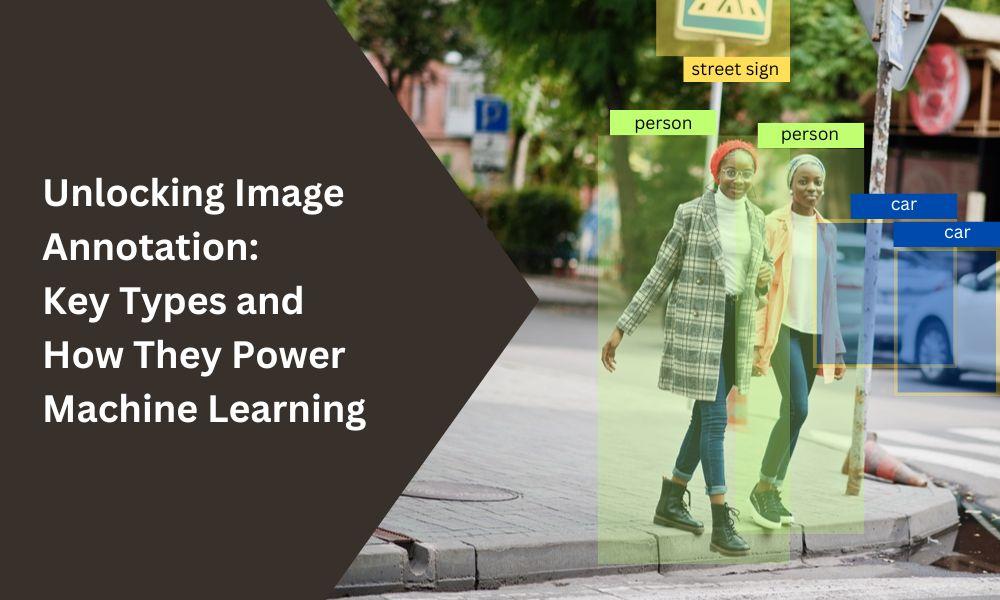Image annotation plays a critical role in machine learning. It serves as the foundation for training algorithms to understand and interpret visual data. From autonomous vehicles to healthcare diagnostics, image annotation empowers ML models to make sense of the visual world. In this article, we’ll examine the key types of image annotation and their applications, highlighting their transformative impact across industries.
What Is Image Annotation?
Image annotation is the process of labeling images with relevant metadata to help ML algorithms recognize objects, classify images, and make informed decisions. By tagging images with precise information, datasets are created to teach machines how to identify patterns and interpret visual cues. These annotations serve as the "ground truth," enabling ML models to learn from real-world data.
Organizations like Powerling leverage their in-depth knowledge of data management to provide customized annotation services that meet the unique needs of their clients, ensuring the highest quality for ML training.
Key Types of Image Annotation
Understanding the different types of image annotation is essential to selecting the right approach for specific ML projects. Each annotation type has unique applications and benefits:
1. Bounding Boxes
Bounding boxes are rectangular boxes drawn around objects of
interest within an image. They are commonly used in object detection to locate
and classify objects such as cars, pedestrians, or animals.
Applications:
- Autonomous vehicles (e.g., identifying other vehicles and pedestrians)
- Retail analytics (e.g., tracking customer movements)
- Surveillance (e.g., monitoring intruders or specific activities)
2. Semantic Segmentation
Semantic segmentation involves dividing an image into
regions based on the objects or areas they represent. Unlike bounding boxes,
segmentation provides pixel-level accuracy, which is crucial for tasks
requiring detailed understanding.
Applications:
- Medical imaging (e.g., identifying tumors in radiology scans)
- Autonomous vehicles (e.g., differentiating between roads, sidewalks, and vegetation)
- Robotics (e.g., navigation in cluttered environments)
3. Polygonal Annotation
Polygonal annotation uses polygons to define the exact shape
of an object, offering a higher level of precision compared to bounding boxes.
This method is ideal for irregularly shaped objects.
Applications:
- Agriculture (e.g., identifying crop boundaries in aerial imagery)
- E-commerce (e.g., accurately tagging products with unique shapes)
- Environmental studies (e.g., mapping water bodies or forested areas)
4. Keypoint Annotation
Keypoint annotation marks specific points of interest on an
object, such as facial landmarks or joint positions. This is particularly
useful for understanding poses or movements.
Applications:
- Augmented reality (e.g., facial recognition for filters)
- Sports analytics (e.g., tracking athlete movements)
- Healthcare (e.g., gait analysis for rehabilitation)
5. 3D Cuboid Annotation
3D cuboid annotation extends the bounding box into three
dimensions, allowing ML models to understand depth and volume. This type of
annotation is essential for applications requiring spatial awareness.
Applications:
- Autonomous vehicles (e.g., detecting distances to objects)
- Warehousing (e.g., identifying object dimensions for automation)
- Robotics (e.g., obstacle detection)
6. Polyline Annotation
Polyline annotation focuses on creating paths or lines in an
image, often used to identify roads, lanes, or structural boundaries.
Applications:
- Autonomous vehicles (e.g., lane detection)
- Urban planning (e.g., mapping infrastructure)
- Construction (e.g., blueprint analysis)
How Powerling Enhances Image Annotation for Machine Learning
Powerling’s commitment to delivering tailored data annotation solutions makes them a valuable partner in the ML space. Their expertise spans industries like manufacturing, retail, and life sciences, where precision in annotation is vital for model accuracy. By combining human expertise with advanced tools, Powerling ensures annotated datasets are both scalable and high-quality.
1. Enhanced Training Data
Annotated images provide labeled data necessary for supervised learning, where models learn from examples and improve their performance over time. Powerling’s data services are designed to enhance dataset quality, resulting in better-trained models.
2. Improved Accuracy
Precise annotations, such as pixel-level labeling in semantic segmentation, ensure higher accuracy for tasks like medical diagnostics and autonomous navigation. Our attention to detail minimizes errors and biases in datasets.
3. Scalability
Powerling offers scalable solutions to meet the growing demand for annotated datasets, ensuring businesses can keep pace with technological advancements.
4. Customization
Powerling’s ability to tailor annotation types to specific industry needs makes us a trusted provider for organizations seeking customized data solutions.
Challenges in Image Annotation
Despite its critical importance, image annotation comes with challenges, including:
- Cost and Time: Annotating large datasets is labor-intensive and expensive.
- Accuracy: Human annotators may introduce errors, leading to biased or flawed datasets.
- Scalability: Annotating diverse datasets for global use can be daunting.
To address these challenges, Powerling employs innovative tools and strategies to streamline the process while maintaining quality, enabling businesses to focus on their core objectives.
The Future of Image Annotation
As ML continues to advance, so will the techniques and tools for image annotation. Emerging technologies, such as AI-driven annotation tools and collaborative platforms, promise to reduce manual effort and enhance annotation accuracy. We are at the forefront of these innovations, driving efficiency and excellence in data services.
Bottom Line
Image annotation is the cornerstone of successful machine learning applications in a visually driven world. From bounding boxes to semantic segmentation and beyond, the variety of annotation types ensures that ML models can be tailored to meet specific needs.
Feel free to contact us to unlock the full potential of your machine learning initiative, leverage the right annotation methods and tools, and pave the way for a smarter, more efficient future. Whether it’s guiding self-driving cars or detecting diseases, the impact of image annotation is profound and far-reaching.

